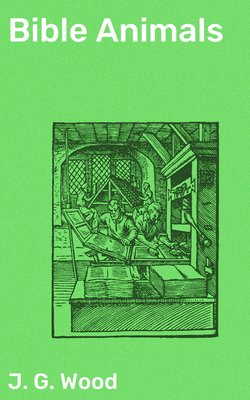Читать книгу Bible Animals - J. G. Wood - Страница 21
THE BADGER.
ОглавлениеDifficulty in identifying the Tachash of Scripture—References to "Badgers' skins"—The Dugong thought to be the Badger—The Bedouin sandals—Nature of the materials for the Tabernacle—Habits of the Badger—The species found in Palestine—Uses of the Badgers' skins—Looseness of zoological terms.
Until very lately, there was much difficulty in ascertaining whether the word Tachash has been rightly translated as Badger. It occurs in several parts of the Scriptures, and almost invariably is used in relation to a skin or fur of some sort. We will first examine the passages in which the Badger is mentioned, and then proceed to identify the animal.
Nearly all the references to the Badger occur in the book of Exodus, and form part of the directions for constructing the Tabernacle and its contents. The first notice of the word occurs in Exodus xxv. 5, where the people of Israel are ordered to bring their offerings for the sanctuary, among which offerings are gold, silver, and brass, blue, purple, and scarlet, fine linen, goats' hair, rams' skins dyed red, badgers' skins, and shittim wood—all these to be used in the construction of the Tabernacle. Then a little farther on, in chapter xxvi. 14, we find one of the special uses to which the badgers' skins were to be put, namely, to make the outer covering or roof of the tabernacle. Another use for the badgers' skins was to form an outer covering for the ark, table of shewbread, and other furniture of the Tabernacle, when the people were on the march.
In all these cases the badger-skin is used as a covering to defend a building or costly furniture, but there is one example where it is employed for a different purpose. This passage occurs in the book of Ezekiel, chapter xvi. 10. The prophet is speaking of Jerusalem under the image of a woman, and uses these words, "I anointed thee with oil; I clothed thee also with broidered work, and shod thee with badger's skin, and I girded thee about with fine linen, and I covered thee with silk. I decked thee also with ornaments, and I put bracelets upon thy hands, and a chain upon thy neck, and I put a jewel on thy forehead, and earrings in thine ears, and a beautiful crown upon thine head."
So we have here the fact, that the same material which was used for the covering of the Tabernacle, and of the sacred furniture, could also be used for the manufacture of shoes. This passage is the more valuable because of an inference which may be drawn from it. The reader will see that the badger-skin, whatever it may have been, must have been something of considerable value, and therefore, in all probability, something of much rarity.
In the present instance, it is classed with the most luxurious robes that were known in those days, and it is worthy of special mention among the bracelet, earrings, necklace, and coronal with which the symbolized city was adorned. If the reader will now refer to the passage in which the children of Israel were commanded to bring their offerings, he will see that in those cases also the badger-skins were ranked with the costliest articles of apparel that could be found, and had evidently been brought from Egypt, the peculiar home of all the arts; together with the vast quantity of gold and jewels which were used for the same sacred purpose.
Now we find that the badger-skins in question must possess three qualities: they must be costly, they must be capable of forming a defence against the weather, and they must be strong enough to be employed in the manufacture of shoes. If we accept the word Tachash as signifying a Badger, we shall find that these conditions have been fulfilled.
But many commentators have thought that badger-skins could not have been procured in sufficient numbers for the purpose, and have therefore conjectured that some other animal must be signified by the word Tachash.
